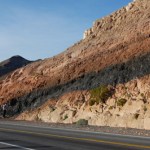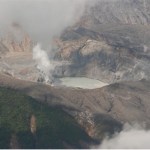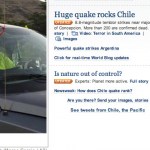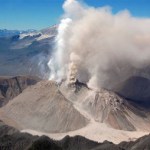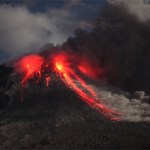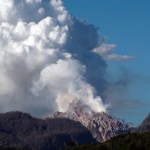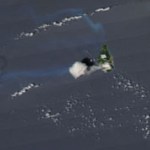Chile
I'm still playing catch-up after my week in the desert, so I've seen a lot of articles I've wanted to mention ... but a certain other volcano has taken up a lot of my time. However, I will attempt to make amends for that now.
By the way, would you believe Ubehebe Crater was closed? How do they close a volcano, anyway? However, I did get a great snap of a welded tuff on the road outside of Shoshone, CA.
A strongly welded tuff near Shoshone, CA. The dark interior is remelted volcanic ash/tephra surrounded by less welded pink tuff with abundant pumice clasts. Denison student David Sisak is on…
Did I mention its a busy week?
The lava lake at Erta'Ale in 2008. Image courtesy of Stromboli Online.
Our Icelandic saga continues, with more earthquakes and more speculation/information on the parts of Eruptions readers. Keep up the discussion - I'll be fascinated to see who turns out to get closest to what actually happens, prediction-wise. The seismicity has quieted somewhat again in the last 12 hours, so we wait eagerly to see what comes next. Remember, Iceland is the land where volcanoes helped change history, so it is always fun to talk Icelandic volcanism.
The NASA Earth Observatory…
Cleaning up some news ... busy week leading up to a field trip I am helping co-lead to Death Valley next week.
Ubehebe Crater in Death Valley, California
First off, I want to say how amazed I am at the great discussion that went on all weekend about the signs of potential activity in Iceland. It now appears that the earthquakes at Eyjafjallajökull may be waning, however the levels of seismicity have definitely bounced up and down over the last few days. However, the level and depth of the conversation is a testament to all volcanophiles out there. Nice job, folks.
For those of you into…
Some news for a busy Tuesday:
The crater at Poas volcano in Costa Rica, taken February 25, 2010. Image courtesy of OVSICORI by Federico Chavarria.
After the MSNBC debacle, it is nice to see some good articles on why the Chilean earthquake was overall less disastrous than the Haitian earthquake, why the tsunami wasn't as large as predicted and why these earthquakes are not abnormal. There are a lot of factors involved - the location, depth, preparedness, wealth - so the comparison can be very telling in terms of both geologic and societal issues.
The other scientific fallout from the Chilean…
News!
Toba caldera in Indonesia.
We're all still talking about the Chilean earthquake and the coverage of the event. If you happen to live in the Columbus area, you might have heard me on WTVN talking about the earthquake as well.
The Toba (Indonesia) eruption 74,000 years ago has been used by some researchers to be the cause of a "genetic bottleneck" for humans - however, that is still much debated. Currently, excavations are under away near Toba to look for evidence of human habitation that was buried by the eruption. The evidence of stone tools that appear to be made by the same human…
I knew I could count on my fellow Science Blogger Dr. Klemetti for a good take on the physical reality of the Chilean Earthquake, so I checked in this morning, only to see him, quite property, take the MSM to task for inane rhetoric, notably an MSNBC headline that reads "Is Nature Out of Control?"
Klemetti rightly observes that this is bad science. He points out:
Earthquakes happen, and they happen in a random distribution (more or less), meaning sometimes we get more, sometimes less. Spend any time looking at the USGS earthquake feed and you'll see sometimes we have lots of M3+ earthquakes…
Screen capture of the MSNBC website on February 27, 2010 at ~5:30 PM eastern time.
Most of you have probably already heard about the magnitude 8.8 earthquake that struck today off the coast of Chile. This becomes one of the most powerful earthquakes on record and so far, the death toll has been relatively low - in the hundreds - especially compared to the horrific disaster of the Haiti earthquake from earlier this year. My thoughts go out to all in Chile recovering from the earthquake.
However, I am a little appalled at some of the coverage I've seen for this earthquake. MSNBC has become the…
The rhyolite domes of Chaiten in Chile in an undated photo. Note how much of the previous Chaiten Caldera has already been filled by the new domes that started after Chaiten erupted in May 2008.
CNN International has a report that the National Emergency Office (ONEMI) in Chile has reinforced the "red alert" status of Chaiten (spanish). The volcano, which has been erupting since May 2008, had recently settled down to slow, but constant, dome growth. However, over the last 3 weeks, seismicity has been increasing at the rhyolite caldera, suggesting that we might be heading towards an upswing of…
Not a lot of big news, but a lot of little news:
Soufriere Hills at night during the late January 2010 dome growth episode. Note the hot rock falls from the collapsing dome. Image courtesy of Photovolcanica.
This might not be new, but Dr. Boris Behncke brought the new webcam at the rim of Chaiten in Chile to my attention. You get a birds-eye view of the growing dome from the edge of the caldera - pretty nifty view for a once-in-a-hundred-years sort of event.
The NASA Earth Observatory has posted a close-up of the Soufriere Hills imagethat I posted yesterday, showing the February 11 plume. The…
This week's USGS/Smithsonian GVP Volcano Update!
Highlights include:
A volcano I had never heard of in the Kuril islands is showing signs of life: Kharimkotan. Satellite images show a thermal anomaly at the summit of the volcano - its last known eruption was in 1933.
Ash, sulfur dioxide and steam continue to erupt from Nyamuragira in the Congo, although lava flows have abated.
Crater C at Arenal had sporadic strombolian activity - which is par for the course for the Costa Rican volcano.
I must have missed this, but since December 14, the ash erupted at Gaua in Vanuatu has become denser and…
2009 is over! If you missed the Volcanic Year in Review, check out my summary of the volcanic events that captivated many of us over the past year. However, only one event will get the coveted 2009 Pliny for Volcanic Event of the Year. A lot of you wrote in with votes and comments - I thank you - and a number of events stood out in your mind. Here we go:
Honorable mention
A few volcanic events got multiple votes:
- Soufriere Hills on Montserrat.
- Mando Hararo in Ethiopia.
- Chaiten, Chile and the new research on the eruption.
- The earthquakes in western Saudi Arabia under the Harrat…
Here it is, my attempt to recap a year's worth of volcanic events. By no means is this supposed to capture every event, but rather the highlight/lowlights and what most captivated me during 2009. I'll be announcing the winner of the 2009 Pliny for Volcanic Event of the Year tomorrow.
Waimangu Geothermal Valley in New Zealand, taken in January 2009 by Erik Klemetti.
January
The year started out with a trip to New Zealand (well, for me at least) and vistas of the Waimangu Valley, formed in the 1886 eruption of Tarawera on the North Island. We were also still thinking about the late 2008…
A new Weekly Volcano Report from the Smithsonian GVP/USGS ... enjoy!
Highlights include:
There has been a number of reports of new activity at Llaima in Chile (hat tip to Eruptions reader Manuel Humeres for bringing them to us). Most of the current activity is steam-and-gas plumes along with long-period seismicity, suggesting we could be headed towards a new eruption.
Lava flows continue to erupt from Kliuchevskoi in Kamchatka, along with strombolian activity throwing ejecta up to 300 m / ~1000 feet above the crater.
Rabaul is busy shaking windows 20 km / 12 miles from the Tavurvur crater,…
We get a new update from the Smithsonian/USGS Global Volcanism Program ...
Highlights (not counting Soufriere Hills or Gaua) include:
The Weekly Report mentions the mystery eruption/noneruption of Karkar in PNG. Specifically, they report:The report also stated that ash had merged with a thunderstorm cloud and had become unidentifiable.
Two ash plumes (11/25, 26) that reached at least 9.1 km / 30,000 feet were reported by the Darwin VAAC ... but as we know, it is far from clear that anything actually happened at Karkar last week.
Activity has quieted significantly at Chaiten in Chile, with…
I'll be giving a talk this afternoon here at Denison on rhyolite generation, so I might be a little brief this morning.
Undated image of Mayon in the Philippines.
The province of Albay in the Philippines is on alert for both a typhoon and a volcano (that country seems to be hit with that 300,000 may need to be ready to evacuate if the volcano continues to show signs that it might erupt - in fact, Mayon is producing ash as of this morning, albeit only one minor ash explosion.
Lava flows from Kilauea are drawing crowds as they inundate a road in Kalapana. There is a nice video link to the…
A few weeks ago I asked you to submit questions on the 2008-present Chaiten eruption in Chile to pose to Dr. Jonathan Castro. Dr. Castro recently had a paper on the ascent rates of Chaiten rhyolite published in Nature and he kindly volunteered to answer your questions. Here are the answers to selected questions ... enjoy!
Chaiten in Chile erupting in 2009. Image by Dr. Jonathan Castro.
Dr. Jonathan CastroBiography:
B.S. from Humboldt State University
Ph.D. from University of Oregon*
Currently a Research Geologist at CNRS-Institut for Sciences de la Terre, Oreans, France
Soon moving on to…
I mentioned this at the end of the post on recent Nature paper by Castro and Dindwell on the speed of rhyolite magma ascent at Chaiten, but I'll break it out to get your attention:
>Do you have a burning question about the Chaiten magma you'd love to be able to ask Dr. Castro? He has kindly offered to answer some questions about Chaiten and his research for Eruptions readers. Send me your questions at
and I'll choose some of them for Dr. Castro to answer. I'll post the interview and the answers to your questions here on the blog.
So do it! Send me your questions for Dr. Castro!
Chaiten has made it back into the news in the past couple days, both with new events at the caldera and with findings from the initial blast in May 2008. Here goes:
Chaiten erupting in 2008.
Third Dome Spotted
The latest USGS/SI Weekly Volcanic Activity Report mentions that over the last week, Chaiten experienced what was likely a significant dome collapse of one of the two domes growing in the caldera. People living close enough to the volcano to see the ash plume noticed it became larger and darker on September 29th. Afterwards, visual observations of the caldera by air confirmed that a…
Sometimes it is hard to keep up with the mountain of remote sensing (or not so remote) images that get released on the internet. Over the last few days, the NASA Earth Observatory has released a bunch of images/videos of current eruptions, so I thought I'd round them all up here for you to peruse.
Soufriere Hills releasing puffs of ash-and-steam on October 6, 2009. Image courtesy of the NASA Earth Observatory.
Four new images in the recent past:
A nice, clear picture of an ash-and-steam plume from Rabaul in PNG was captured by the Terra satellite's MODIS imager on September 30, 2009. The…
As fall descends on the northern hemisphere, spring starts in the southern. Luckily for us, it means that we get better views of the southern Andes in Chile ... which means the NASA EO could train one of the many "eyes in the sky" (specifically the EO-1) on Chaiten. The volcano is still erupting, going on 16 months, since it caught everyone off guard in May of 2008. As you can tell from the image (linked and below), Chaiten is slowly filling in the pre-2008 caldera with new rhyolite dome growth - you can see that the pre-2008 dome within the caldera (see the picture taken from the ISS in 2003…
